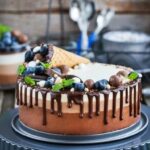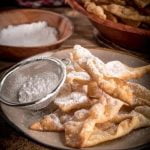Naked cakes have become a popular trend in the world of baking, offering a unique and rustic aesthetic that sets them apart from traditional frosted cakes. In this article, we will explore the appeal of naked cakes and provide a comprehensive guide on how to decorate them to perfection. Whether you’re a seasoned baker or a novice in the kitchen, mastering the art of decorating naked cakes can add a beautiful and delicious element to your culinary repertoire.
The concept of a naked cake is simple yet elegant, with its exposed layers and minimal frosting allowing the natural beauty of the cake to shine through. As we delve into the step-by-step process of decorating a naked cake, you’ll discover tips for selecting the perfect base flavor and texture, preparing the cake layers with precision, creating a stabilizing base for assembly, and choosing a theme or color scheme that suits your design vision.
With our guidance, you’ll also learn about selecting and applying delectable fillings, adorning your creation with fresh flowers and fruit, and adding those final touches that elevate your naked cake from ordinary to extraordinary. Whether it’s for a special occasion or just as a delightful indulgence, decorating a naked cake is an art form that holds an allure all its own.
Let’s embark on this journey together and unlock the secrets to crafting stunning naked cakes that are both visually captivating and irresistibly delicious.
Choosing the Perfect Naked Cake Base
When preparing to decorate a naked cake, the first and most crucial decision is choosing the perfect cake base. The appeal of a naked cake lies in its simplicity, making it essential to select a flavor and texture that will shine through the minimal frosting or filling. Popular options for naked cake bases include vanilla, chocolate, lemon, and even more unique flavors like red velvet or carrot cake.
When selecting the cake base for your naked cake, consider the overall theme or occasion for which the cake is being prepared. For example, a vanilla or lemon cake may be ideal for a spring wedding or baby shower, while a rich chocolate or red velvet cake could be perfect for a decadent celebration like an anniversary or birthday.
The texture of the cake is also important when choosing a base for a naked cake. A moist and tender crumb is key to achieving the desired look and taste. Be sure to select a recipe or mix that promises a soft and delicate texture, as this will ensure that each slice of the finished naked cake is as delightful to eat as it is beautiful to behold.
By carefully considering both flavor and texture when choosing the perfect naked cake base, you can set yourself up for success in creating an exquisite dessert that will wow your guests. Experiment with different flavor combinations and textures to find what works best for your specific event or celebration. With a well-chosen base, you’ll have a solid foundation upon which to build and decorate your stunning naked cake masterpiece.
Preparing the Cake Layers
First, prepare the batter according to your chosen flavor and recipe. Be sure to mix the ingredients thoroughly to achieve a smooth consistency. Once the batter is ready, divide it evenly among your cake pans and smooth out the surface.
Next, adjust your oven racks to ensure even baking and preheat the oven to the correct temperature. Place the cake pans in the center of the oven and set a timer based on your recipe’s recommended baking time.
After removing the baked cakes from the oven, allow them to cool in their pans for about 10 minutes before transferring them to a wire rack. This will help prevent them from sticking to the pan while also allowing air to circulate around them.
Once completely cooled, it’s important to handle the cake layers carefully when assembling your naked cake. Look for a moist but sturdy texture that will hold up well against fillings and decorations.
| Baking Steps | Cake Layers Preparation |
|---|---|
| Prepare batter | Mix ingredients thoroughly |
| Bake at correct temperature | Divide batter evenly among pans |
| Cool cakes properly | Transfer cakes to wire rack after cooling in pan |
How to Create a Stabilizing Base and Assembly
Creating a stable base and assembling the cake layers are crucial steps in the process of decorating a naked cake. Without a sturdy foundation, the cake may tilt or collapse, ruining all your hard work. Here’s how to ensure that your naked cake stays intact throughout the decorating process.
Assembling and Stabilizing Cake Layers
Once you have baked and cooled your cake layers, it’s time to assemble them into a multi-layered masterpiece. Start by placing the first layer on a flat serving plate or cake stand. To create a stable base, spread a thin layer of frosting or filling on top of the first cake layer.
This will help anchor the next layer in place. Continue this process with each additional layer, making sure to press down gently to ensure they adhere to one another.
Creating a Sturdy Base
To prevent tilting or collapsing, it’s essential to build a strong foundation for your naked cake. If you’re working with multiple tiers, consider using wooden or plastic dowels inserted into the bottom layers for support. These dowels will provide stability and prevent any shifting or sliding as you continue decorating the cake.
Tips for Success
When assembling your naked cake, take your time and pay attention to stability at every step. Use enough frosting or filling between each layer to provide cohesion without adding too much weight that it causes the layers to slide. As you add each new layer, rotate them slightly so that any imperfections in shape can be smoothed out as you add more layers.
Finally, chill the assembled layers for about 15 minutes before moving on to further decoration to give them extra stability as you work. With these tips in mind, your naked cake will be well-prepared for an array of beautiful decorations without sacrificing structural integrity.
Deciding on a Theme or Color Scheme
When it comes to decorating a naked cake, one of the key decisions is choosing a theme or color scheme that complements the natural and rustic aesthetic of the cake. Whether you’re preparing a naked cake for a wedding, birthday, or other special occasion, the theme and color scheme can set the tone for the entire cake design.
Complementing the Natural Aesthetic
One of the main appeals of a naked cake is its organic and understated beauty. When deciding on a theme or color scheme, it’s important to consider elements that enhance this natural aesthetic. Earthy tones such as soft greens, pale pinks, or light yellows can work well for a nature-inspired theme. Alternatively, for a more elegant look, consider metallic accents in gold or silver paired with neutral shades like white or ivory.
Coordinating With the Occasion
The theme and color scheme of your naked cake should also harmonize with the occasion for which it is being served. For instance, for a springtime wedding, pastel hues and floral motifs might be fitting choices. On the other hand, for a whimsical birthday celebration, vibrant colors and playful decorations could be more appropriate. By aligning the cake’s design with the event’s style and ambiance, you can create a cohesive and visually appealing presentation.
Incorporating Personal Touches
Another aspect to consider when selecting a theme or color scheme for your naked cake is incorporating personal touches that hold significance to you or the intended recipient. This could involve using specific colors that hold sentimental value or integrating elements that reflect shared interests or hobbies. By infusing personal meaning into the design, you can make the decorated naked cake even more meaningful and memorable.
By carefully deciding on an appropriate theme or color scheme for your naked cake, you can enhance its visual appeal and tailor it to suit any special occasion. Whether opting for natural inspiration, coordinating with event themes, or including personal touches, there are numerous creative opportunities to make your decorated naked cake truly stand out.
Selecting and Applying Fillings
When it comes to decorating a naked cake, the filling plays a crucial role in both flavor and presentation. The right filling can add moisture, enhance the taste of the cake layers, and contribute to the overall aesthetic appeal of the dessert.
There are various options for fillings, including fruit preserves, whipped cream, chocolate ganache, or even caramel. It’s essential to select a filling that not only complements the flavor of the cake but also adds visual interest to the exposed layers.
To apply fillings to a naked cake, start by placing one layer of cake on a serving plate or cake stand. Using a spatula or piping bag, evenly spread or pipe the filling over the surface of the cake layer. Take care not to spread the filling all the way to the edges as it may ooze out when additional layers are added. Repeat this process for each layer of cake, ensuring that each layer is level and evenly filled.
When selecting and applying fillings for a naked cake, consider how different flavors and textures will work together. For example, pairing a vanilla cake with fresh raspberry preserves can create a delightful contrast of sweet and tart flavors. Alternatively, opting for a rich chocolate ganache filling in between layers of red velvet cake can add decadence to each bite. Experiment with different combinations to find the perfect balance for your naked cake.
In addition to flavor considerations, pay attention to the consistency of your chosen fillings. They should be thick enough to stay in place between layers without causing them to slide but still spreadable enough to create an even distribution across each surface. By carefully selecting and applying fillings for your naked cake, you can elevate its taste and appearance while adding your own creative touch to this trendy dessert.
Decorating With Fresh Flowers and Fruit
Decorating a naked cake with fresh flowers and fruit is a beautiful way to enhance the natural, rustic charm of this unique dessert. With the right selection and arrangement, these organic elements can add a pop of color, texture, and fragrance to your cake. Here’s how to decorate a naked cake with fresh flowers and fruit:
- Choose Your Flowers Wisely: When selecting flowers for your naked cake, opt for varieties that are pesticide-free and non-toxic. Popular choices include roses, peonies, daisies, lavender, or any edible blooms. It’s crucial to ensure that the flowers you choose are safe for consumption.
- Preparing the Flowers: Before placing the flowers on the cake, make sure to trim their stems and remove any foliage that may come into contact with the frosting or filling. This will prevent any potential contamination of the cake.
- Arranging the Flowers: Once you have prepared your flowers, carefully arrange them on top of the cake in a visually pleasing manner. You can create a cascading effect by placing the blooms on one side of the cake or opt for a simple, elegant cluster in the center.
In addition to fresh flowers, incorporating seasonal fruits into your naked cake can also elevate its visual appeal and add delicious flavor profiles. Here’s how to incorporate fruit into your naked cake decoration:
- Selecting Fruits: Choose fruits that are in season and complement the flavors of your cake. Berries such as strawberries, raspberries, blueberries, or sliced citrus fruits like lemons or oranges work beautifully with naked cakes.
- Slicing and Arranging: Wash and pat dry your chosen fruits before slicing them uniformly. Arrange the fruit slices on top of the cake in an artful manner. Consider layering different types of fruits for a vibrant and eye-catching presentation.
- Final Preparations: Once you have adorned your naked cake with fresh flowers and fruit, take care not to refrigerate it for too long as moisture from refrigeration can affect their appearance. Serve your decorated masterpiece at room temperature for best results.
By following these guidelines for decorating with fresh flowers and fruit, you’ll be able to create a stunning naked cake that not only looks exquisite but also tantalizes the taste buds with its delightful combination of flavors. Whether it’s for a wedding, birthday celebration, or any special occasion, this visually striking confection is sure to leave a lasting impression on all who indulge in it.
Adding the Final Touches
In conclusion, decorating a naked cake provides a wonderful opportunity to showcase the natural beauty and simplicity of this trendy dessert. By following the steps outlined in this article, you can learn how to decorate a naked cake with style and flair. From choosing the perfect flavor and texture for your cake base to adding the final touches that make it truly stand out, there are countless ways to personalize and enhance your creation.
One of the key aspects of decorating a naked cake is selecting the right theme or color scheme to complement its simplistic yet elegant appearance. Whether you’re planning for a birthday celebration, wedding reception, or any other special event, coordinating the decorations with the overall theme can elevate the visual impact of your naked cake.
Fresh flowers and fruit can also be used to add a pop of color and bring a touch of nature to your dessert, creating a stunning focal point for any occasion.
Finally, as you put the finishing touches on your decorated naked cake, don’t be afraid to get creative and let your imagination run wild. Adding elements such as powdered sugar, edible glitter, or decorative garnishes can transform your creation into a work of art. With attention to detail and a focus on presentation, you can achieve a visually appealing and delicious masterpiece that will impress all who have the pleasure of enjoying it.
Frequently Asked Questions
How Do You Make a Plain Cake Look Nice?
To make a plain cake look nice, you can dust it with powdered sugar, drizzle a glaze over it, add sliced fruits or berries on top, or even sprinkle some chopped nuts or chocolate shavings for visual appeal.
What Can I Put on a Cake Instead of Frosting?
Instead of frosting, you can opt for whipped cream, ganache, fruit preserves, or even a simple dusting of cocoa powder. These alternatives can add flavor and visual interest to the cake without using traditional frosting.
What Is a Cake Without Frosting Called?
A cake without frosting is often called a “naked cake.” This trendy style showcases the layers of the cake and allows for creative decorating with fruits, flowers, or other decorative elements on the visible layers. Naked cakes have a rustic charm and are perfect for those who prefer less sweetness in their desserts.

Welcome to our cake decorating blog! My name is Destiny Flores, and I am the proud owner of a cake decorating business named Cake Karma. Our mission is to provide delicious, beautiful cakes for all occasions. We specialize in creating custom cakes that are tailored specifically to each customer’s individual needs and tastes.





